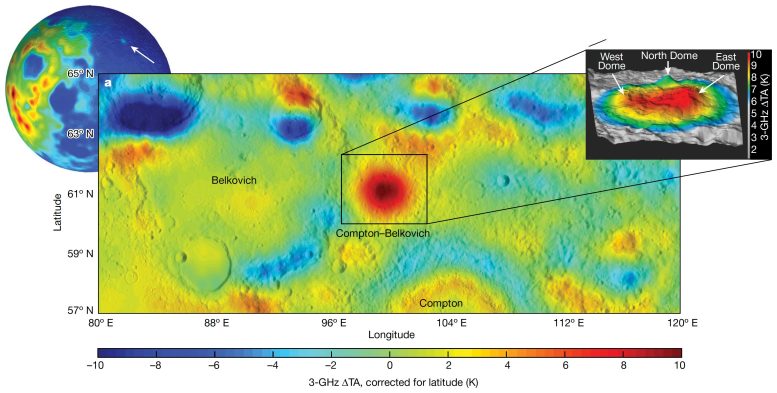
A team of scientists used microwave frequency data to measure heat below the surface of a suspected volcanic feature on the Moon known as Compton-Belkovich. Credit: Nature
Microwave frequency data from lunar orbiter reveals deposit of cooled magma beneath a volcano that likely erupted 3.5 billion years ago.
Scientists have discovered a large granite formation beneath the Moon’s surface, pointing to ancient volcanic activity and challenging existing theories about the lunar crust’s formation. The presence of granite, a rock type typically associated with water and plate tectonics, also raises questions about past conditions on the Moon.
A large formation of granite discovered below the lunar surface likely was formed from the cooling of molten lava that fed a volcano or volcanoes that erupted early in the Moon’s history – as long as 3.5 billion years ago.
A team of scientists led by Matthew Siegler, an SMU research professor and research scientist with the Planetary Science Institute, has published a study in the journal Nature that used microwave frequency data to measure heat below the surface of a suspected volcanic feature on the Moon known as Compton-Belkovich. The team used the data to determine that the heat being generated below the surface is coming from a concentration of radioactive elements that can only exist on the Moon as granite.
Granites are the igneous rock remnants of the plumbing systems below extinct volcanos. The granite formation left when lava cools without erupting is known as a batholith.
“Any big body of granite that we find on Earth used to feed a big bunch of volcanoes, much like a large system is feeding the Cascade volcanoes in the Pacific Northwest today,” Siegler said. “Batholiths are much bigger than the volcanoes they feed on the surface. For example, the Sierra Nevada mountains are a batholith, left from a volcanic chain in the western United States that existed long ago.”
The lunar batholith is located in a region of the Moon previously identified as a volcanic complex, but researchers are surprised at its size, with an estimated diameter of 50 kilometers.
Granite is somewhat common on Earth, and its formation is generally driven by water and plate tectonics, which aid in creating large melt bodies below the Earth’s surface. However, granites are extremely rare on the Moon, which lacks these processes.
Finding this granite body helps explain how the early lunar crust formed.
“If you don’t have water it takes extreme situations to make granite,” Siegler said. “So, here’s this system with no water, and no plate tectonics – but you have granite. Was there water on the moon – at least in this one spot? Or was it just especially hot?”
Reference: “Remote detection of a lunar granitic batholith at Compton–Belkovich” by Matthew A. Siegler, Jianqing Feng, Katelyn Lehman-Franco, Jeffery C. Andrews-Hanna, Rita C. Economos, Michael St. Clair, Chase Million, James W. Head, Timothy D. Glotch and Mackenzie N. White, 5 July 2023, Nature.
DOI: 10.1038/s41586-023-06183-5
Research team members included Jianquing Fang, from the Planetary Science Institute; Katelyn Lehman-Franco, Rita Economos and Mackenzie White from SMU; Jeffrey Andrews-Hanna from Southwest Research Institute; Michael St. Clair and Chase Million from Million Concepts; James Head III from Brown University and Timothy Glotch from Stony Brook University.
The work was funded through NASA’s Lunar Data Analysis Program and work related to the Lunar Reconnaissance Orbiter Diviner Lunar Radiometer.
Data for the study was obtained from public data released from two Chinese lunar orbiters, Chang’E-1 in 2010 and Chang’E-2 in 2012, carrying four-channel microwave radiometer instruments. The original Chang’E‐1 and Chang’E-2 MRM data can be downloaded from: http://moon.bao.ac.cn/index_en.jsp.
Siegler will be presenting the team’s research at the upcoming Goldschmidt Conference, scheduled for July 9-14 in Lyon, France.

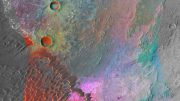

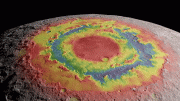
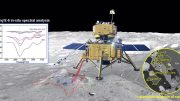



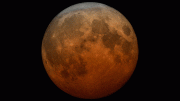
Why did it take 10 years or so to release the data from the Chinese orbiter? Was information withheld for that long ? was it just now made public or is this old news you are writing about